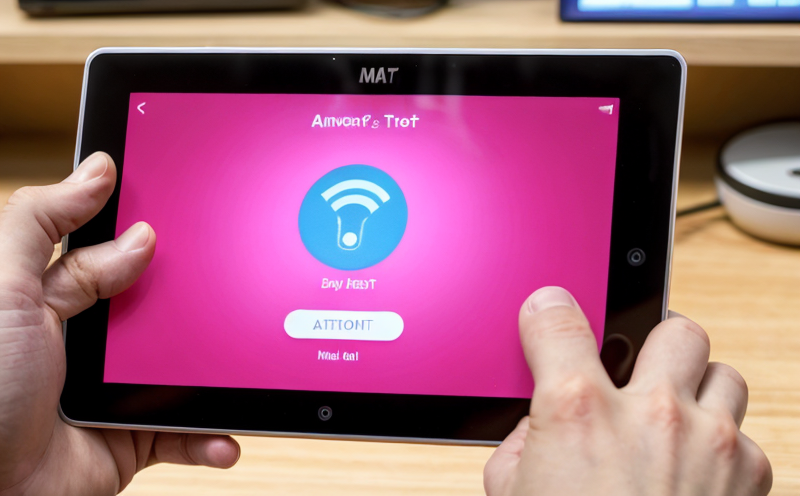Conducted Emission Testing of Connected Devices
In today’s interconnected world, smart and connected consumer devices have become an indispensable part of our daily lives. These devices range from wearable tech to smart home appliances, all designed to enhance convenience and connectivity. However, the integration of wireless technologies in these products also brings challenges related to electromagnetic compatibility (EMC) and emissions. Conducting emission testing is crucial for ensuring that these devices do not interfere with other electronic systems or cause harmful effects when they are used.
Our team specializes in conducting emission tests on connected consumer devices, ensuring compliance with international standards such as ISO 14598-1 and ASTM F2607. This testing involves measuring the electromagnetic emissions of these devices to ensure they meet regulatory limits set forth by authorities like the Federal Communications Commission (FCC) in the United States. By adhering to these standards, we help our clients mitigate risks associated with non-compliance and protect their brand reputation.
The process begins with a thorough review of the product design documentation provided by our clients. This allows us to understand the specific features and functionalities that could impact emissions levels. Specimen preparation involves setting up test samples according to predefined guidelines, ensuring they are representative of real-world usage scenarios. Once prepared, the devices undergo rigorous testing in controlled environments where emission levels can be accurately measured using advanced instrumentation such as spectrum analyzers.
Testing typically includes both conducted and radiated emissions tests. Conducted emissions measure the electrical signals that flow through cables or wires connecting different parts of a device. Radiated emissions, on the other hand, focus on the radio frequency (RF) signals emitted by antennas within the device itself. Both types of testing are critical for identifying potential sources of interference between devices operating in close proximity to each other.
The data collected during these tests is analyzed against established thresholds outlined in relevant standards. If any deviations from acceptable limits are detected, our team works closely with clients to identify root causes and implement corrective actions where necessary. Our goal is not only to ensure compliance but also to provide valuable insights that can inform future product development decisions aimed at minimizing emissions while maintaining optimal performance.
| Scope | Methodology |
|---|---|
| Conducted Emissions Testing | Measure electrical signals flowing through cables or wires connecting different parts of a device. This helps identify any potential sources of interference between devices operating in close proximity to each other. |
| Radiated Emissions Testing | Focus on the radio frequency (RF) signals emitted by antennas within the device itself. Ensures that these emissions do not exceed allowable limits set forth by regulatory bodies like the FCC in the United States. |
Scope and Methodology
The scope of our conducted emission testing encompasses a wide range of smart and connected consumer devices. These may include but are not limited to wearable technology such as fitness trackers, smartwatches, and augmented reality glasses; home automation products like thermostats, lighting systems, and security cameras; and even IoT-enabled appliances such as refrigerators or washing machines.
- Wearable technology: Fitness trackers, smartwatches, augmented reality glasses
- Home automation: Thermostats, lighting systems, security cameras
- IoT-enabled appliances: Refrigerators, washing machines
We employ a multi-step methodology to ensure accurate and reliable results. The process starts with careful review of the device’s design documentation followed by specimen preparation tailored specifically for each type of product being tested. Specimen preparation ensures that the test sample accurately represents typical user conditions under which it will operate in real-world environments.
- Review of Design Documentation
- Specimen Preparation
- Emission Testing (Conducted & Radiated)
- Data Analysis Against Established Thresholds
Benefits
- Avoids potential interference between devices operating in close proximity to each other.
- Ensures compliance with international standards and regulatory requirements set forth by authorities like the FCC in the United States.
- Protects your brand reputation from damage caused by non-compliance issues or harmful emissions.
- Provides valuable insights into product performance that can inform future development decisions aimed at minimizing emissions while maintaining optimal functionality.
Environmental and Sustainability Contributions
Emission testing plays a crucial role in promoting environmental sustainability by helping manufacturers design products that minimize their impact on the environment. By ensuring that connected consumer devices meet stringent emissions standards, we contribute to reducing electromagnetic interference (EMI) which can lead to wasted energy consumption elsewhere.
- Reduces EMI leading to reduced wastage of energy consumption elsewhere
- Promotes responsible use and disposal practices for electronic waste management
- Supports the development of more efficient products that consume less power during operation





